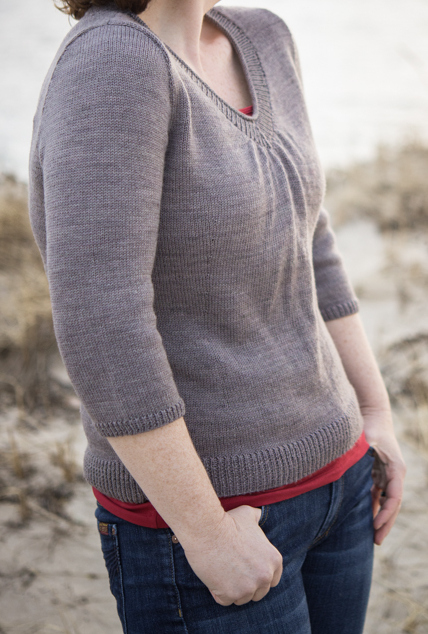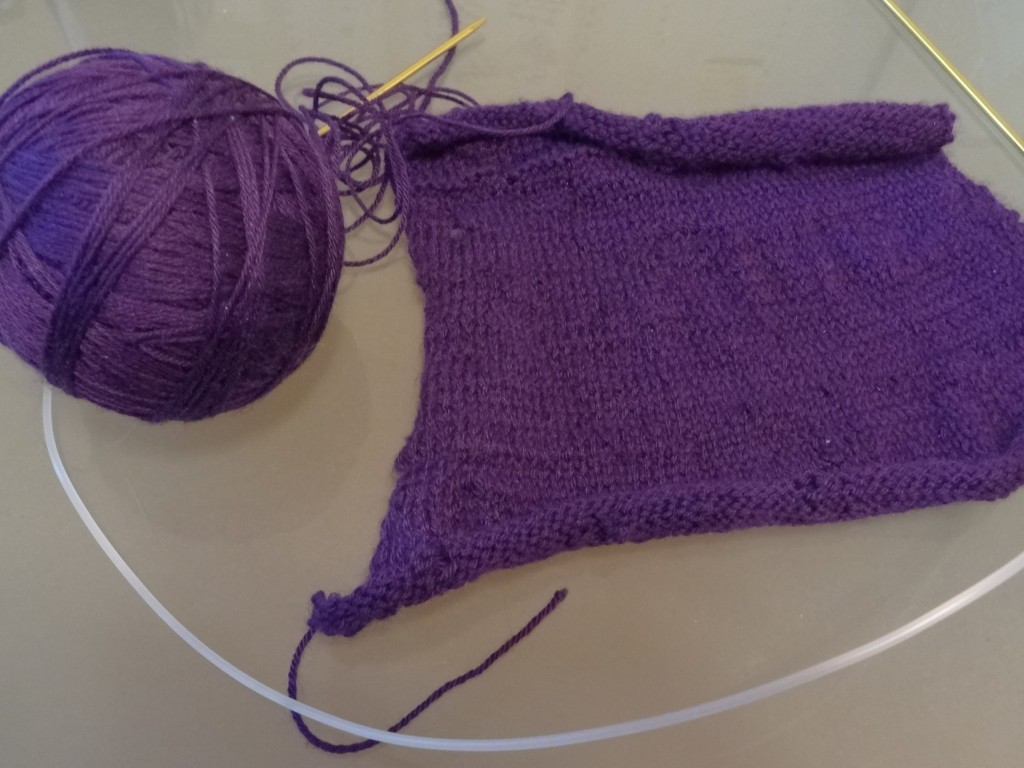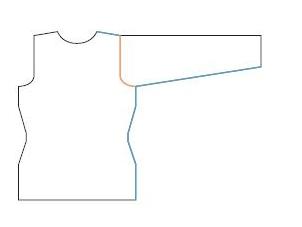This is the Amy Herzog sweater I have vowed to knit. It’s different from the one I posted when I first wrote about my determination to learn to knit because I want something super basic for my very first sweater.
This is the purple yarn I’m knitting it in. Below is the swatch to determine whether my gauge (stitches per inch) matches that of the pattern. I spent three weeks on this 10″ X 8″ rectangle. At this rate, I should finish by the fall of 2014!
Interestingly, in her workshop, Amy told us not to wait until we reach a desired weight to begin knitting because there’s a 30-pound-range in which a sweater will fit us. In other words, a sweater will still fit me whether I gain 15 pounds or lose 15 pounds. So even if it does take me over a year to finish this sweater, there’s a good chance it will still fit me.
Today I’m sitting down and trying to understand the pattern, and it’s putting me in a cranky mood because it seems very complicated to me. Instead of detailing the complicated features here, however, I thought you’d be interested in reading how I determined which size to knit.
My bust measures 45 1/2″ around the apex, but I chose the sweater size for someone with a 40″ bust. That’s because most patterns are created for Miss Average, whose shoulders and bust measure almost the same. To figure out how much fabric I needed for my shoulders, I had to measure my “torso circumference” by pulling the measuring tape all the way up into my armpits and over my bust. Now where have you seen this measuring technique used before?
This is almost how Victoria’s Secret tells you to figure out your bra band size! I’m curious whether this is somehow connected to their rationale for using the overbust measurement. Anyhow, Amy Herzog uses this measurement to determine what shoulder size you need. I need a 40 1/2″ shoulder size. The closest pattern size fits a 40″ bust, and because Miss Average’s 40″ bust would be the same as her 40″ shoulder, that’s the size I’m going with.
Somewhere along the line I will be adding the extra 5 1/2 inches that I need for my bust. Even though I’m pretty intimidated by the prospect (I’m still struggling to understand how to cast on and rib), it sounds a LOT easier than altering the armscye. As Amy explains in her book,
Regardless of construction, all sweaters are three tubes: one for the torso and two for the arms. They’re joined together at the top in some (usually complicated) way, because we ourselves are joined together at the top in a fairly complicated way. The general principle of simplifying modifications is to ensure that the top of the sweater fits your shoulders—trying to fiddle with very complex sleeve cap math is much more challenging than making three or four easy modifications elsewhere.
You’ve stacked the deck in your favor by choosing a size based on your upper torso, which ensures you’re making the easiest mods possible. This is a departure from the typical recommenÂdation to knit to bust size, but if you choose a size to fit your shoulders properly, most modifications you need to make will be easy . . . even if your sweater is knit in pieces!
Modifications that don’t affect a seam will cause no interference when you go to piece the sweater together. The illustration below shows the pieces of a seamed sweater, with the seams highlighted in blue and orange.The orange seam is for the set-in sleeve and you shouldn’t need to modify this if you’ve chosen the right base size. So we’ll skip those modifications . . . and focus instead on modifications that either don’t affect seams at all or that affect only the blue seams (shoulders, sides, and sleeves).
In addition to adding inches for my bust, I’m considering deepening the neckline of this sweater dramatically and perhaps shortening the sleeves to elbow-length, although I’m also fine with the 3/4 sleeves. Let me know if you have any other suggestions. And if you’re thinking of jumping into the knitting pool, the water’s fine! I’d love to do this project together with you. I just added it as my first project on Ravelry today, so you can follow along there when I’m not writing about it here.




Is that jumper really super basic? It looks amazing to me! How I would love to have my own custom knitter (you know, for free… like a mum or someone). I can’t knit at all. Did crochet at one point.
I think with jumpers (that’s Australian for sweaters) only a deep V looks good on my large bust. A shallow V just sits above my bust and makes it look (unflatteringly) broad.
Plus, unlike a cardigan, the V is the only bit breaking up the torso, there’s no other vertical interest, unlike the line of buttons on a cardie.
Good knitting!
Oh, and the info about the 30 pound range in which a sweater will fit – this is why I love wool knits (and knits in general) so much! They just stretch and fit to your body… hourglass nirvana!
It’s also recommended to use the over bust measurement to choose your starting size for sewing patterns, and add room at bust level and below if necessary, for the same reason: it’s often easier to change the pattern at torso level than at the shoulders.
I actually like that sweater better than the one you firts posted!